The challenge of sealing against a dynamic surface has been around since the frontier era. The first known seals were leather straps used to retain animal fat on the end of a wheel axle. This crude method of sealing often leaked and required routine maintenance.

The Industrial Revolution spawned the development of engines, transmissions and gearboxes. All of these systems had challenging sealing requirements. The seals of the industrial age were organic ropes or packings. These seals proved to be very effective until speeds, temperatures and other parameters increased with the development of better transportation systems. In the late 1920’s, a self contained shaft seal was created from oil resistant leather assembled into a metal case. This was the first radial lip seal to take advantage of a metal pressfit as an outside diameter (O.D.) seal.
The most significant development in the evolution of the radial lip seal happened toward the end of World War II. A synthetic, oil-resistant rubber nitrile replaced the leather element, forever changing seal design. Methods for bonding rubber to metal soon followed and, by the 1950’s, direct bonded seals were available. High temperature elastomers were developed in the 1960’s and included silicone, polyacrylate and fluorocarbon. The increased price of these materials encouraged manufacturers to reduce material volume to stay cost effective. The resulting seal of the 1970’s remains one of the most common designs today. The 1980’s brought an important change in radial lip seal design. The dynamic sealing surface was incorporated into the seal assembly. Doing this created a series of lips with vertical and horizontal contact points. This integral system was the first step manufacturers took to take responsibility for the entire sealing system and not just the seal. This allowed them to provide a value added package, not just a commodity.
The future of radial lip seals will be centered around the relationship between customer and manufacturer. The advancement of machinery design will depend on these relationships; the first to be successful will lead the next phase in seal evolution.